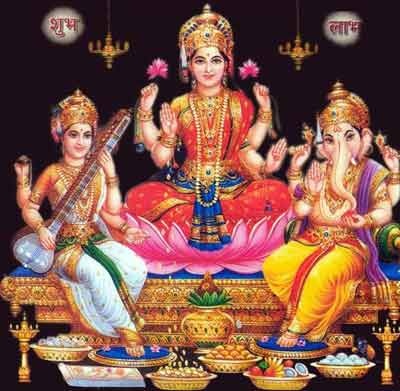Diwali
(Ashwin 28th) and ending on the 2nd day of the bright half of the five day festival of Deepavali is centered on the new moon day that ends the month of Ashwin and begins the month of Kartika, beginning on the 13th day of the dark half of AshwinKartika (Kartika 2nd). The main day of celebration varies regionally.[2][3][4]In Hinduism, across many parts of India and Nepal, it is the homecoming of Rama after a 14-year exile in the forest and his victory over Ravana.[5] In the legend, the people of Ayodhya (the capital of his kingdom) welcomed Rama by lighting rows (avali) of lamps (dĭpa), thus its name: dīpāwali. Over time, this word transformed into Deepavali in Hindi and Dipawali in Nepali, but still retained its original form in South and East Indian Languages. In Tamil it is called as Deepavali and the same is used in Malaysia and Singapore. Tamils never say Diwali as it means Firebucket.
In Jainism, Deepavali marks the attainment of nirvana by Mahavira on 15 October, 527 BC.
Deepavali has been significant in Sikhism since the illumination of the town of Amritsar commemorating the return of Guru Har Gobind Ji (1595-1644), the sixth Guru of Sikhism, who was imprisoned along with 52 other Hindu kings at Fort Gwalior by Emperor Jahangir. After freeing the other prisoners, he went to the Darbar Sahib (Golden Temple) in the holy city of Amritsar, where he was welcomed happily by the people who lit candles and divas to greet the Guru. Because of this, Sikhs often refer to Deepavali also as Bandi Chhorh Divas - "the day of release of detainees."
The festival is also celebrated by Buddhists in Nepal, a majority-Hindu country, particularly the Newar Buddhists.
In India and Nepal, Deepavali is now considered to be a national festival, and the aesthetic aspect of the festival is enjoyed by most Indians and Nepalese regardless of faith.[6] Kerala is the only state in India where Deepavali is not a big celeberation.
Kidha is celebrated for a differing number of days by different communities. Though the core days are common and fall on exactly the same set of days across Nepal and India, they fall in different Gregorian months depending on the version of the Hindu calendar being used in the region. The Amanta ("ending on the new-moon") version of the Hindu Calendar has been adopted as the Indian national calendar. According to this calendar, which is prevalent in southern India and Maharashtra, the 6-day celebration is spread over the last four days of the month of Ashwina and the first two days of the new month of Kartika. According to the Purnimaanta ("ending on the full-moon") version prevalent in northern India, it falls in the middle of the month of Ashwayuja/Ashvin. In the Gregorian calendar, it falls generally in the months of October or November. In Nepal, it is celebrated according to Nepalese calendar. The festival marks the last three days and the first two days of Nepalese era.
On the day of Deepavali / Deepavali, many wear new clothes and share sweets and snacks. Some North Indian business communities start their financial year on Deepavali and new account books are opened on this day.




No comments:
Post a Comment